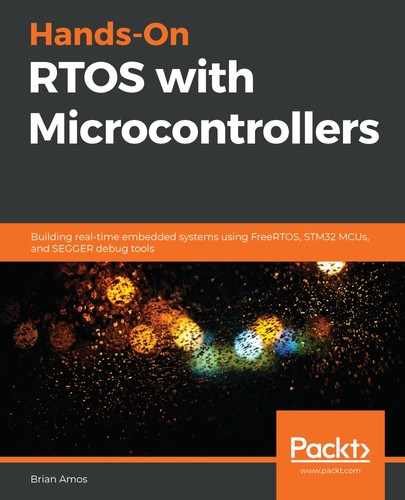To illustrate the range of timing requirements that can be encountered, let's consider a few different systems that acquire readings from analog-to-digital converters (ADCs).
The first system we'll look at is a control system that is set up to control the temperature of a soldering iron (as seen in the following diagram). The parts of the system we're concerned with are the MCU, ADC, sensor, and heater.
The MCU is responsible for the following:
- Taking readings from a temperature sensor via the ADC
- Running a closed-loop control algorithm (to maintain a constant temperature at the soldering iron tip)
- Adjusting the output of the heater as needed
These can be seen in the following diagram:

Since the temperature of the tip doesn't change incredibly quickly, the MCU may only need to acquire 50 ADC samples per second (50 Hz). The control algorithm responsible for adjusting the heater (to maintain a constant temperature) runs at an even slower pace, 5 Hz:

The ADC will assert a hardware line, signaling a conversion has been completed and is ready for the MCU to transfer the reading to its internal memory. The MCU reading the ADC has up to 20 ms to transfer data from the ADC to internal memory before a new reading needs to be taken (as seen in the following diagram). The MCU also needs to be running the control algorithm to calculate the updated values for the heater output at 5 Hz (200 ms). Both of these cases (although not particularly fast) are examples of real-time requirements:

Now, on the other end of the ADC reading spectrum, we could have a high bandwidth network analyzer or oscilloscope that is going to be reading an ADC at a rate of tens of GHz! The raw ADC readings will likely be converted into the frequency domain and graphically displayed on a high-resolution front panel dozens of times a second. A system like this requires huge amounts of processing to be performed and must adhere to extremely tight timing requirements, if it is to function properly.
Somewhere in the middle of the spectrum, you'll find systems such as closed-loop motion controllers, which will typically need to execute their PID control loops between hundreds of Hz to tens of kHz in order to provide stability in a fast-moving system. So, how fast is real-time? Well, as you can see from the ADC examples alone, it depends.
In some of the previous cases, such as the oscilloscope or soldering iron, failure to meet a timing requirement results in poor performance or incorrect data being reported. In the case of the soldering iron, this might be poor temperature control (which could cause damage to components). For the test equipment, missing deadlines could cause erroneous readings, which is a failure. This may not seem like a big deal to some people, but for the users of that equipment, who are relying on the accuracy of the data being reported, it is likely to matter a great deal. Some laboratory equipment that is used in standard verification provides checks for product conformance. If there is an undetected malfunction in the equipment that results in an inaccurate measurement, an incorrect value could be reported. It may be possible for a suspect test to be rerun. Eventually, however, if retesting is required too often and reliable readings can't be counted on, then the test equipment will start to become suspect and viewed as unreliable and sales will decline—all because a real-time requirement wasn't being consistently met.
In other systems, such as the flight control of a UAV or motion control in industrial process control, failing to run the control algorithm in a timely manner could result in something more physically catastrophic, such as a crash. In this case, the consequences are potentially life-threatening.
Thankfully, there are steps that can be taken to avoid all of these failure scenarios.
